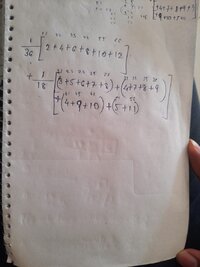While calculating the expectation value of problems in which an event is done n times, like rolling a dice n times, playing roulette n times, etc., we simply multiply expectation of event being done once with n.
But shouldn't we calculate the Expectation by proper method? The answer is both of those scenario isn't matching for me.
Let's take the specific example of rolling a dice 2 times. We need to calculate the expected value of the sum
What I've seen people doing is - E(sum of 2 dice) = 2*E(sum of one dice)
But if I calculate E properly :-
E(sum of 2 dice) = sum(xf(x)) = sum(P(sum is x)*(value of x))
This does not match with the answer above.
Please see the attached image.
Why is this so?
But shouldn't we calculate the Expectation by proper method? The answer is both of those scenario isn't matching for me.
Let's take the specific example of rolling a dice 2 times. We need to calculate the expected value of the sum
What I've seen people doing is - E(sum of 2 dice) = 2*E(sum of one dice)
But if I calculate E properly :-
E(sum of 2 dice) = sum(xf(x)) = sum(P(sum is x)*(value of x))
This does not match with the answer above.
Please see the attached image.
Why is this so?



